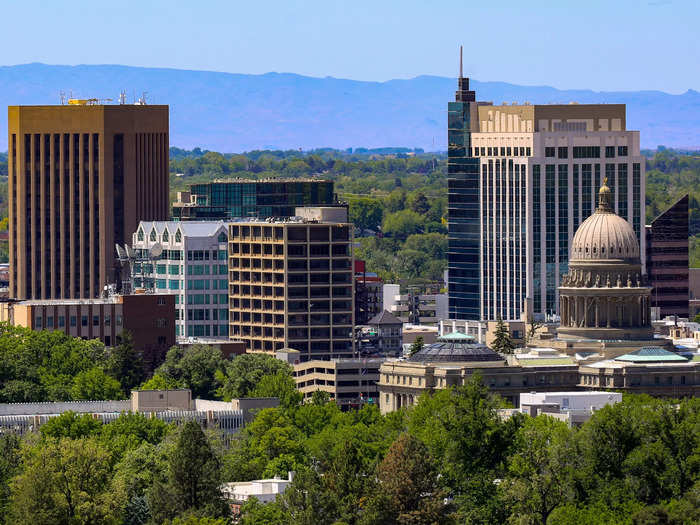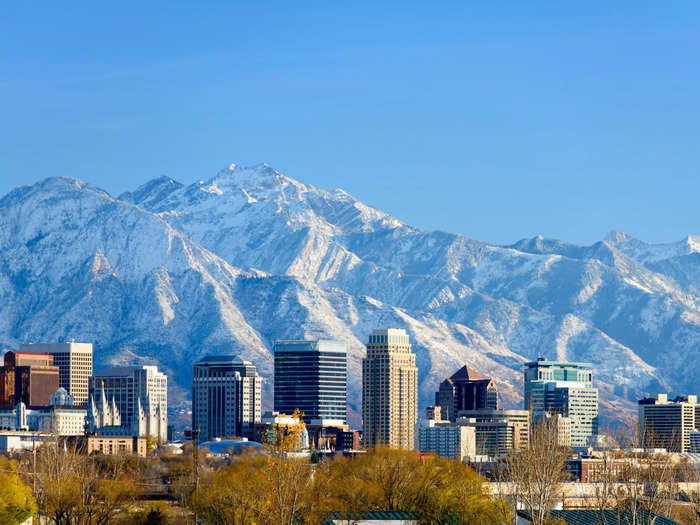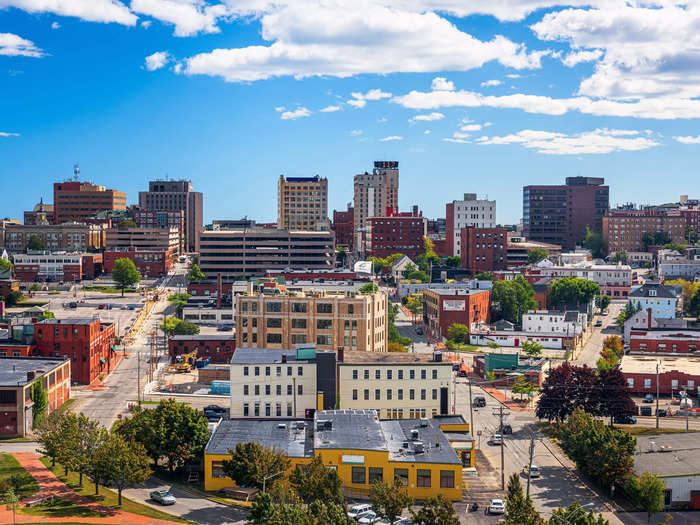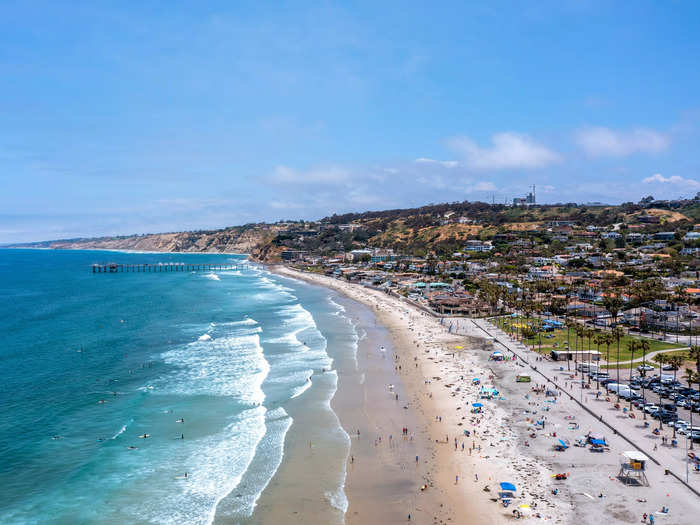Hawaii is the best-ranked state for women's equality.Wolfgang Hauke/Shutterstock
- WalletHub released its ranking of the best and worst states for gender equality in 2024.
- The study compared disparities between men and women across metrics like income and test scores.
In June 2024, the World Economic Forum released its "Global Gender Gap Report 2024," which documented the state of gender equality using economic participation and opportunity, educational attainment, health and survival, and political empowerment as its dimensions.
The US ranked 43rd, with a score of 0.747 out of 1.0.
However, men's and women's experiences can differ greatly from state to state.
WalletHub compared these differences in experiences in three categories: workplace environment, political empowerment, and education and health, using 17 metrics, such as income disparity, disparity in advanced educational attainment, and disparity in the share of lawmakers.
Outlet analyst Chip Lupo told BI, "The states at the top of the list, they tend to have lawmakers at the state and federal level that support legislation in favor of women's equality, as opposed to those ones at the bottom where there doesn't seem to be a whole lot of progress being made."
The data used in WalletHub's report was accurate as of July 22, 2024, and was collected from the US Census Bureau, the Bureau of Labor Statistics, the Nation's Report Card, and the Center for American Women and Politics, among other sources.
From Texas to Hawaii, here are the five worst and five best states for gender equality in 2024.
WORST: 5. Missouri
Missouri was ranked the fifth-worst state for women's equality. Sean Pavone/Shutterstock
Missouri was ranked the fifth-worst state for gender equality, with bottom-10 finishes in each category.
The state's lowest ranking was in political empowerment, finishing in 48th place.
Of Missouri's 10 seats in Congress, only two belong to women. At the state level, less than 30% of the legislature is women and there are no women in elected executive positions.
The state finished 45th overall for education and health, and 43rd for workplace environment.
4. Idaho
Idaho ranked in the bottom 10 states for all categories. CSNafzger/Shutterstock
Idaho also ranked in the bottom 10 states for all categories, with its lowest ranking in political empowerment.
Only two women have ever served in Congress for Idaho, the last of whom was Helen Chenoweth-Hage, who served three consecutive terms in the House of Representatives from 1995 to 2001.
The state also had the second-largest advanced educational attainment gap, according to WalletHub. The US Census Bureau's 2022 American Community Survey five-year estimates reported that 10.8% of men 25 and older in Idaho had received a graduate or professional degree compared to 9.3% of women 25 and older.
The Bureau of Labor Statistics (BLS) also reported that in 2022, women in Idaho earned about 78.4% of what men did, with median weekly earnings totaling $851 for women compared to $1,085 for men.
3. Wyoming
Wyoming ranked in the bottom five states for workplace environment and education and health. EQRoy/Shutterstock
Wyoming ranked in the bottom five states for workplace environment and education and health, finishing 49th and 47th, respectively.
WalletHub reported that the state, which is nicknamed "The Equality State," actually had the third-largest income gap in the country.
Per the BLS, women in Wyoming earned 75.6% of what men made in 2022, with median weekly earnings totaling $869 and $1,150, respectively.
The National Women's Law Center also reported that 12.3% of women in the state live in poverty, which is 0.5% higher than the national figure.
It fared much better in political empowerment, ranking 19th among all states. Two of its three congressional seats are occupied by women.
2. Texas
Texas ranked 49th in education and health. travelview/Shutterstock
Texas is the second-worst state for women in the US, receiving a mix of medium-to-low rankings across categories.
For example, the "Lone Star State" ranked 23rd overall for workplace environment.
Lupo told BI that "even in your most business-friendly states, there's still some disparities among the genders," citing the juxtaposition between Texas' No. 1 ranking for job security and its "very low rankings in higher income disparity."
The state also placed 49th for education and health. One metric used to score this category was disparity in math test scores.
According to the Nation's Report Card, on average, grade-four boys scored seven points higher than girls in math, and grade-eight boys scored five points higher.
Finally, Texas ranked 40th for political empowerment, with seven women in Congress out of an available 40 seats.
1: Utah is the worst-ranked state for gender equality.
Utah was the lowest-ranked state for women's equality. Only 4K Ultra HD/Shutterstock
Utah is the worst-ranked state for gender equality with last-place finishes for both workplace environment and education and health, according to WalletHub's report. The state also ranked in the bottom 10 for political empowerment.
The "Beehive State" had the largest income gap according to WalletHub, with the BLS reporting that women made 73.1% of what men made in 2022, as their median weekly earnings totaled $884 and $1,210, respectively.
Utah also had the largest advanced educational attainment gap; the US Census Bureau's 2022 ACS five-year estimates reported that 14.5% of men 25 and older had received a graduate or professional degree compared to just 10% of women 25 and older.
Finally, the state only has one woman filling its six available seats in Congress, and fewer than 30% of people in its state legislature are women.
BEST: 5. New Mexico
New Mexico ranked in the top 10 states for workplace environment. Arina P Habich/Shutterstock
New Mexico ranked in the top 20 states for each category, with its highest ranking in workplace environment at No. 8.
According to WalletHub, the state had one of the smallest gaps in executive positions. The BLS also reported that New Mexico ranked 20th overall for income disparity in 2022, with women making 83.6% of what men made, with median weekly earnings totaling $855 compared to $1,023.
The state also ranked highly for political empowerment. Two of the state's five available seats in Congress belong to women as well as four of seven statewide elective executive positions. The New Mexico state legislature is also 43.8% women.
4. Maine
Maine ranked first for political empowerment. Sean Pavone/Shutterstock
Maine was the No. 1 ranked state in the country for political empowerment.
Half of the state's seats in Congress belong to women, and women compose 42.5% of the state legislature. Maine's only statewide executive, the governor, is also a woman, Janet T. Mills.
Maine is also one of four states where more women have received an advanced education than men. The Census's 2022 ACS five-year estimates reported that 14.1% of women 25 and older had received a graduate or professional degree compared to 11.4% of men 25 and older.
3. Minnesota
Minnesota ranked in the top five states for political empowerment. Sean Pavone/Shutterstock
Minnesota is ranked the third-best state for gender equality, with top-10 finishes in workplace environment and political empowerment.
The "North Star State" has the third-smallest income gap in the country. Women earn 91% of what men make, with median weekly earnings totaling $936 and $1,093.
According to the Census's 2022 ACS five-year estimates, women are also more likely to have graduate or professional degrees than men: 14% of women hold advanced degrees compared to 12.5% of men.
Meanwhile, six of Minnesota's 10 seats in Congress belong to women, as well as 40% of statewide elective executive positions. More than a third of the state legislature consists of women, too.
2. California
California is the second-best ranked state for women's equality. Kyle J Little/Shutterstock
California is the No. 2 state for gender equality in the US, with a top-five ranking for workplace environment, a top-10 ranking for political empowerment, and a top-20 ranking for education and health.
California has the seventh-smallest income gap in the country, with women earning 86.8% of what men do — $1,062 in median weekly earnings compared to $1,223.
The "Golden State" also has one of the smallest advanced educational attainment gaps, with 13.8% of women 25 and older earning graduate or professional degrees compared to 13.7% of men 25 and older, according to the Census's 2022 ACS five-year estimates.
WalletHub also reported that California has a particularly low gender disparity among higher-income earners, as "only 8.1% more men achieve salaries of $100K+ than women." (Vermont is the only state where this gap is lower).
One-third of California's seats in Congress belong to women, as well as more than 40% of its state legislature and 50% of its statewide elective executives.
1. Hawaii is the No. 1 state for gender equality in the US.
Hawaii is the best-ranked state for women's equality. Wolfgang Hauke/Shutterstock
The "Aloha State" earned top-5 rankings in every category, with a No. 1 ranking in education and health.
According to the Nation's Report Card, grade-four boys only scored three points higher than grade-four girls in math, and by eighth grade, there was no difference in scores. Women were also more likely to receive graduate or professional degrees, with 13.1% of women 25 and older earning advanced degrees compared to 11.9% of men 25 and older.
Hawaii also ranked second for political empowerment, with 50% of its seats in Congress belonging to women, as well as 50% of statewide elective executives, and more than a third of seats in the state legislature.
Finally, WalletHub reported that there is no gap in the rate of men and women working minimum-wage jobs, and the gaps in unemployment and job security are less than 1%.










